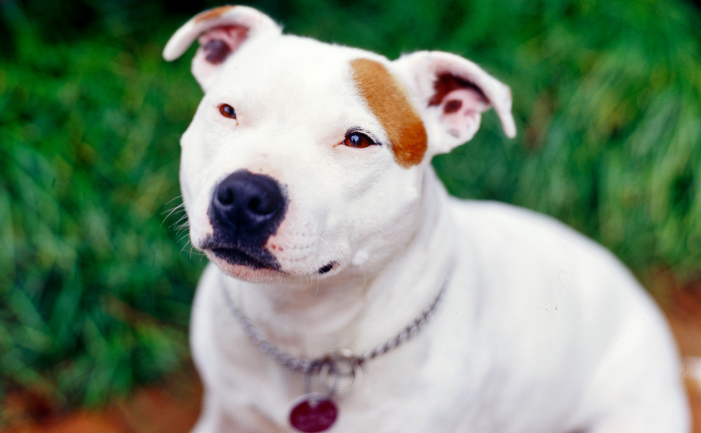Breed: Staffordshire Bull Terrier
Temperament: tenacious and playful, occasionally aggressive towards other dogs.
Lifespan: 12 years
Recommended for: families with older children (from age eight upwards)
Maintenance: medium
Tough, stocky and boisterous, Staffordshire Bull Terriers are clear winners as one of Australia’s favourite dogs. Once bull-baiters, modern Staffies are friendly to a fault, well behaved if trained early and adored by their owners. NOTE: Staffordshire Bull Terriers are sometimes confused with the American Staffordshire Terrier, Burke’s Backyard does not support the keeping of the American Staffordshire Terrier. They are too dangerous to be kept as pets.
Appearance:
Staffies are well muscled in the hindquarters with a strong tail. Coat colours are red, fawn, white, black or blue, or any of these colours with white. Any shade of brindle or brindle with white is also acceptable. Staffies stand about 35-40cm (14-16″) at the withers (or back). Dogs weigh 13-17kg (30-40lb) and bitches 11-15kg (25-35lb).
Temperament:
The breed is very human-oriented and loyal, although they can be aggressive to other dogs. ‘Burke’s Backyard’ vet, Dr Rob Zammit, says it is important that between eight and 18 weeks pups are well socialised, especially with children and other dogs. Breeders warn, too, that the friendly nature of most Staffies means they go to strangers readily and risk being stolen for use in illegal dog fights.
Health:
While a hardy little animal, breeders report that up to 50 per cent of births are by caesarean section. There are usually six to eight pups per litters. Like most members of the Bulldog/Bull terrier group, Staffies rush in where angels fear to tread leading to accident-prone behaviour, and they rarely develop road sense.
Some Staffies can suffer from hip dysplasia (degenerative bone disease), luxating patellas (slipping kneecaps) and entropion (an eye disease), but none are common in the breed.
Pale-coloured dogs, or dogs with pale noses, are susceptible to sunburn and skin cancer.
Breeders also report that up to 50 per cent of births are by caesarean section, possibly due to their broad skull and narrow pelvis. There are usually six to eight pups per litter.
Maintenance:
Staffies shed little hair and can be house-trained. Fortnightly bathing is adequate if the dog spends most of its time indoors. While they enjoy a walk (20 minutes is ideal), most are also happy lounge lizards.
Ideal owners:
Staffordshire Bull Terriers are suited to families with children aged over eight years. They are strong, enthusiastic dogs and may bump over smaller children, and they are said to be good watchdogs.
History:
Staffordshire in England is the birthplace of two very different products: fine china (Wedgwood and Spode), and one of Australia’s most popular dogs, the Staffordshire Bull Terrier.
While Josiah Wedgwood was slaving away at his kiln in the 1700s, just down the road the Staffies’ forebears were probably being readied for another round of bull-baiting. It was thought beef would be tough unless the beast was ‘hot’ before slaughter and so Staffordshire Bull Terriers were developed to tease cattle. Whether an honest belief or an excuse for cruelty, bull-baiting was a popular pastime, later replaced by dog fights. Today’s dog, however, is literally centuries away, and is proving to be a faithful, attractive and surprisingly popular choice for pet owners.
Surprising because it is not a breed immediately recognisable from other bull terriers. Yet owners are besotted by these strong, stocky dogs, with their broad skulls and short snout.
National contacts
To find up-to-date contacts for breeders, contact the following organisations:
Dogs NSW
www.dogsnsw.org.au
Email: [email protected]
Phone: 1300 728 022 (NSW only) or (02) 9834 3022
Fax: (02) 9834 3872
Dogs Victoria
http://www.vca.org.au
Email: [email protected]
Phone: (03) 9788 2500
Fax: (03) 9788 2599
Dogs ACT
http://www.actca.asn.au
Email: [email protected]
Phone: (02) 6241 4404 – Fax: (02) 6241 1129.
Dogs West
http://www.cawa.asn.au
Email: [email protected]
Phone: (08) 9455 1188
Fax: (08) 9455 1190
Dogs SA
http://dogssa.com.au
Phone: (08) 8349 4797
Canine Control Council of Queensland
http://www.cccq.org.au
Email: [email protected]
Phone: (07) 3252 2661
Fax: (07) 3252 3864
Tasmanian Canine Association
http://www.tasdogs.com
Email: [email protected]
Phone: (03) 6272 9443
Fax: (03) 6273 0844
Dogs NT
http://www.territorydogworld.com
Email: [email protected]
Phone: (08) 8984 3570
Fax: (08) 8984 3409



